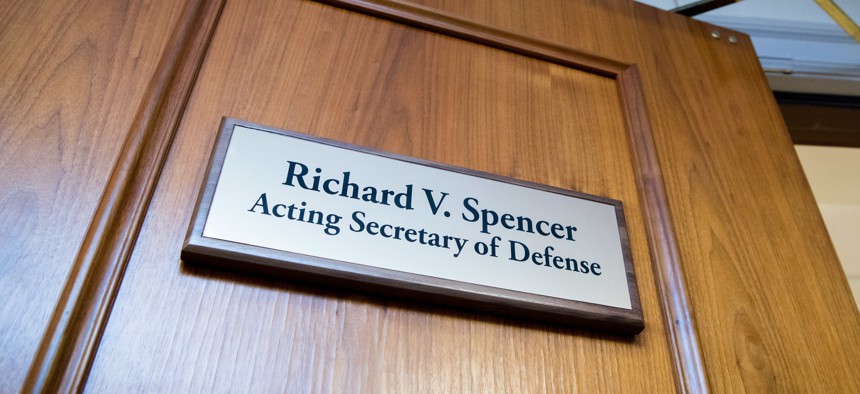
The defense secretary's office at the Pentagon. U.S. Army Sgt. Amber I. Smith
Inside the Pentagon’s Game of Musical Chairs
Richard V. Spencer is the year’s third acting defense secretary — but there are a lot more moving pieces than that.
At 3:04 p.m. on Monday, Navy Secretary Richard V. Spencer became the third acting defense secretary since January. That’s when President Trump formally nominated Spencer’s predecessor, three-weeks-on-the-job Mark Esper, to become defense secretary proper.
Spencer’s short walk from one E-Ring office to another belied an immense jump in responsibility, from a service secretary in charge of manning and equipping a pair of service branches to a practitioner of global strategy and the second link in the wartime chain of command. How long will he keep the job? No one knows.
It’s the latest move in a bizarre game of musical chairs playing out at the Pentagon, which now has vacancies at 18 top political positions. And that game could continue well into the summer.
“We will not presume confirmation and it is the prerogative of the Senate to take as long as they think is necessary to examine and confirm the nominee,” Eric Chewning, chief of staff to the acting defense secretary, said at an impromptu briefing at the Pentagon on Monday afternoon. “Secretary Spencer is prepared to remain in the role until there is a Senate-confirmed secretary of defense.”
Esper has served since 2017 as Secretary of the Army, a position he did not formally relinquish when he was named Acting Defense Secretary on June 24. His formal nomination means he can no longer serve in an acting capacity, so he is now once more Army secretary.
“Secretary Spencer has the full authority and responsibility of the Secretary of Defense,” Jonathan Hoffman, the Pentagon’s chief spokesman, said in a statement. “The senior team supporting the Office of the Secretary remains in place to ensure institutional continuity.”
Pentagon officials are hoping for a speedy Senate confirmation. The Senate Armed Services Committee has scheduled Esper’s confirmation hearing for Tuesday morning.
At the Pentagon, Esper’s picture at the Pentagon’s River Entrance, the one used by most senior defense officials and foreign dignitaries, has been removed and replaced with a picture of Spencer. But even if Esper’s confirmation moves quickly, Spencer’s picture could remain high on the leadership wall for some time.
That’s because David Norquist, the Pentagon comptroller and CFO, who has also been “performing the duties” of the deputy defense secretary since January, is then expected to receive a formal nomination from Trump to be deputy defense secretary. At that point, Norquist will go back to being comptroller and Spencer will “perform the duties” of the deputy defense secretary.
Assuming the Senate confirms Norquist, Spencer would then go back to being Navy secretary.
Trump had planned to nominate Patrick Shanahan, the former deputy defense secretary for the Pentagon’s top post. But Shanahan, who served as acting defense secretary for six-plus months, withdrew from consideration and resigned as deputy secretary after details of a messy divorce became public.
But there’s more. The White House has still not formally nominated Barbara Barrett, who Trump, in May, said he would nominate as Air Force secretary. Also, Trump has said he would nominate Ryan McCarthy, the Army undersecretary to replace Esper as Army secretary.
That would mean two more Senate confirmations, one for McCarthy and one for whoever the White House nominates for Army undersecretary.
Then there’s the uniformed side of the house. The Senate last week held a confirmation hearing for Gen. Mark Milley, the Army chief of staff, to become Chairman of the Joint Chiefs of Staff. Also, the nomination of Air Force Gen. John Hyten, head of U.S. Strategic Command, to be Joint Chiefs vice chairman has been in limbo following sexual assault allegations.
Correction: This story originally misstated the position to which Gen. Milley has been nominated.




